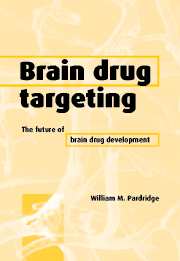Book contents
- Frontmatter
- Contents
- Preface
- List of abbreviations
- 1 Drug targeting, drug discovery, and brain drug development
- 2 Invasive brain drug delivery
- 3 Lipid-mediated transport and carrier-mediated transport of small molecules
- 4 Receptor-mediated transcytosis of peptides
- 5 Vector discovery: genetically engineered Trojan horses for drug targeting
- 6 Linker strategies: the engineering of multifunctional drug formulations
- 7 Protein neurotherapeutics and peptide radiopharmaceuticals
- 8 Antisense neurotherapeutics and imaging gene expression in vivo
- 9 Gene therapy of the brain
- 10 Blood–brain barrier genomics
- References
- Index
- Plate section
9 - Gene therapy of the brain
Published online by Cambridge University Press: 08 January 2010
- Frontmatter
- Contents
- Preface
- List of abbreviations
- 1 Drug targeting, drug discovery, and brain drug development
- 2 Invasive brain drug delivery
- 3 Lipid-mediated transport and carrier-mediated transport of small molecules
- 4 Receptor-mediated transcytosis of peptides
- 5 Vector discovery: genetically engineered Trojan horses for drug targeting
- 6 Linker strategies: the engineering of multifunctional drug formulations
- 7 Protein neurotherapeutics and peptide radiopharmaceuticals
- 8 Antisense neurotherapeutics and imaging gene expression in vivo
- 9 Gene therapy of the brain
- 10 Blood–brain barrier genomics
- References
- Index
- Plate section
Summary
Introduction
Gene therapy is a paradigm shift in the development of pharmaceuticals, and much more so than any changes brought about by the introduction of biotechnology to classical pharmaceutics. As discussed in the Preface, present-day pharmaceutics is a chemistry-driven science that originated early in the twentieth century (Drews, 2000), and is based almost singularly on drug discovery of small molecules. The introduction of recombinant DNA technology and biotechnology represent only changes in the methodology of drug discovery. The large pharmaceutical industry uses biotechnology to clone receptors and establish high-throughput screening (HTS) programs to identify classical organic small molecules. The singular focus on organic small molecules, and the belief that these molecules are able to diffuse freely across biological membranes, underlies the persistent inattention to drugtargeting science on the part of the pharmaceutical industry. The reason that gene therapy is such a paradigm shift is that gene therapy requires a primary emphasis in drug development on biology, not chemistry. The development of genes as drugs also brings into focus the need for new technologies that enable the targeting of genes, or drugs, through the biological membrane barriers of the body.
Four barriers in gene targeting
Gene therapy, should it be implemented successfully, could obviate the need for classical organic small molecules for many types of chronic disease or cancer. However, gene therapy will not be widely used unless the gene formulations are incorporated into a targeting technology that enables the gene medicine to traverse the various biological barriers that exist between blood and brain.
- Type
- Chapter
- Information
- Brain Drug TargetingThe Future of Brain Drug Development, pp. 251 - 274Publisher: Cambridge University PressPrint publication year: 2001



